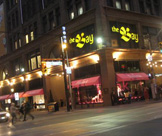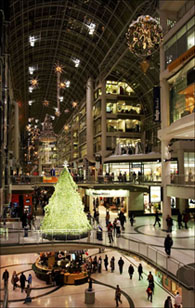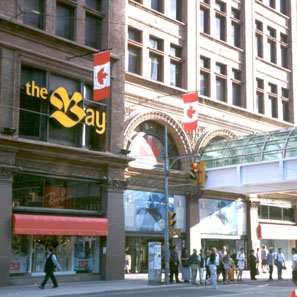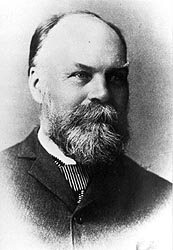Saturday, 19 July 2008
 I once took a girl to the Georgian Room on the ninth floor of the old Eatonís department store in Toronto. It must have been around 1970. I was in my 20s by that point. I had been going to the Georgian Room since before I could remember, with my mother and brother and aunts and cousins ó for cream of chicken soup, peanut butter sandwiches, and ice cream with a cookie in the middle, served with solid silverware in the old high style of the global empire, on which the sun never dared to set. (Or so it pretended in democratic North America, right next door to the USA.) But this was the first time I had ever taken anyone to the Georgian Room myself, as an adult. And at some point we were standing in the lobby, by a window that framed the streetscape below from nine floors up. It was nighttime and the city lights were glittering. I looked out the window and suddenly felt that I had grown up at last. Now all this comes rushing back to me in the summer of 2008, as I read that: "The Hudson's Bay Co. has been bought by the owner of upscale American department store chain Lord & Taylor, which plans to expand its brand into Canada and give a fresh approach to both the Bay and Zellers." Suddenly again the last vestiges of something I still somehow like seem about to vanish forever. And I think of the crazy 19th century poem by Alfred, Lord Tennyson: "Tears, idle tears, I know not what they mean / Tears from the depth of some divine despair ..." I once took a girl to the Georgian Room on the ninth floor of the old Eatonís department store in Toronto. It must have been around 1970. I was in my 20s by that point. I had been going to the Georgian Room since before I could remember, with my mother and brother and aunts and cousins ó for cream of chicken soup, peanut butter sandwiches, and ice cream with a cookie in the middle, served with solid silverware in the old high style of the global empire, on which the sun never dared to set. (Or so it pretended in democratic North America, right next door to the USA.) But this was the first time I had ever taken anyone to the Georgian Room myself, as an adult. And at some point we were standing in the lobby, by a window that framed the streetscape below from nine floors up. It was nighttime and the city lights were glittering. I looked out the window and suddenly felt that I had grown up at last. Now all this comes rushing back to me in the summer of 2008, as I read that: "The Hudson's Bay Co. has been bought by the owner of upscale American department store chain Lord & Taylor, which plans to expand its brand into Canada and give a fresh approach to both the Bay and Zellers." Suddenly again the last vestiges of something I still somehow like seem about to vanish forever. And I think of the crazy 19th century poem by Alfred, Lord Tennyson: "Tears, idle tears, I know not what they mean / Tears from the depth of some divine despair ..."
The way we were ... in the most ancient days
 Everyone hates Toronto, as the Canadian proverb has it ó and that often seems to include quite a few who actually live there at any particular point in time. To follow the exact logic of how the Georgian Room at Eatonís in 1970 finally leads to the Hudsonís Bay Company store across the street 38 years later may seem tedious to many readers. Everyone hates Toronto, as the Canadian proverb has it ó and that often seems to include quite a few who actually live there at any particular point in time. To follow the exact logic of how the Georgian Room at Eatonís in 1970 finally leads to the Hudsonís Bay Company store across the street 38 years later may seem tedious to many readers.
So I will try to cover just the essential parts of the journey as quickly as possible ó while encouraging non-Torontonians to substitute stores and streets in their own cities, that may have somewhat similar nostalgic tales to tell. ("There are a million stories in the naked city," as many many millions of us learned on North American TV, long ago ... )
Back in 1970 it was already the end of an era, if only I had seriously known it then. But I did know that not all girls of my generation would have been impressed by dinner at the Georgian Room, to say the least. It took someone a little quirky and imaginative to appreciate that scene in 1970 ó like the girl I took on this occasion.
In any case, at that point Eatonís was still on the north side of Queen Street, on the west side of Yonge, right downtown. And its department store rival of that day, Simpsonís, was on the south side of Queen, on the west side of Yonge. Some said Simpsonís was more of a carriage trade store, and Eatonís was more for the unwashed masses (and East European Jews etc, etc) , But if you came from a family of Old Eatonians, as I did, you couldnít believe any of that. (And besides it was often said that my grandfather from London, England looked like an East European Jew.)
The rise of the Eaton Centre ... and the arrival of the Bay on the south side of Queen at Yonge ...
 From a little research I have just done on the remarkable world wide web, it seems that 1971 was the point at which this ancient Toronto universe began to turn into something more like the corner of Queen and Yonge streets today. (And 1971 also marks the death of the fabled old Toronto newspaper known as The Telegram ó which probably fits the picture too.) From a little research I have just done on the remarkable world wide web, it seems that 1971 was the point at which this ancient Toronto universe began to turn into something more like the corner of Queen and Yonge streets today. (And 1971 also marks the death of the fabled old Toronto newspaper known as The Telegram ó which probably fits the picture too.)
The now of course defunct Eatonís empire was perhaps the closest Toronto ever came to realizing the cross-Canada commercial imperialism it has so often been charged with in other parts of the country. In 1971, in any event, the empire began to act on long-simmering plans to turn its old Queen and Yonge properties into a new downtown shopping mall, with its own main Toronto department store to the north at Dundas rather than Queen Street. The north end of the complex opened in 1977, and the south end in 1979. The old downtown Toronto world of "Eaton's large Main Store, the Eaton's Annex and a number of related mail order and factory buildings" was changed forever.
Meanwhile, on the south side of Queen Street, so to speak, in 1978 the "Hudson's Bay Company took over the Simpsons chain at the same time as it acquired Zellers, dramatically expanding its presence in the market." And then, more than a decade later, the last act in this drama unfolded, when in "1991, the last Simpsons store, the flagship Toronto downtown store, was finally converted to the Bay banner, and all remaining Simpsons operations were folded into the Bay. That store still operates today as the Bay, Queen Street."
(And here I should quickly remind everyone that the Hudsonís Bay Company was founded in 1670 ó as a great fur-trading enterprise, and the first department store for the aboriginal peoples of at least the more northwesterly parts of Canada. In my own early Canadian days, "the Bay" was strictly a Western adornment. As I discovered on a trip to Winnipeg, however, it had nonetheless pioneered the old high style of the global empire that I first encountered at the Georgian Room in Toronto, long before Timothy Eaton began his version of this British North American heritage in the later 19th century.)
How the last days of Simpsonís and then the Bay, Queen Street became the Toronto downtown of my childhood that lived on into my adult years (or something like that) ...
 To make a long story very short, in the late 1970s and early 1980s I discovered that I did not really like the new Eatonís store in the new Eaton Centre ó even though I was descended from a (sort of) long line of Old Eatonians. (At least as such things were judged in the still rather new and crass city of Toronto: or "hogtown" to its many enemies across Canada. In my case my immigrant grandfather finally wound up with a job at Eatonís in Toronto in the early 20th century. He rose through the ranks and it made his life in the new country. At various points it also employed his brother-in-law, son, daughter, nephew, and no doubt various other friends and relations I have forgotten or never really knew about in the first place.) To make a long story very short, in the late 1970s and early 1980s I discovered that I did not really like the new Eatonís store in the new Eaton Centre ó even though I was descended from a (sort of) long line of Old Eatonians. (At least as such things were judged in the still rather new and crass city of Toronto: or "hogtown" to its many enemies across Canada. In my case my immigrant grandfather finally wound up with a job at Eatonís in Toronto in the early 20th century. He rose through the ranks and it made his life in the new country. At various points it also employed his brother-in-law, son, daughter, nephew, and no doubt various other friends and relations I have forgotten or never really knew about in the first place.)
It may be that I was not alone in my feelings about the new Eatonís store in the new Eaton Centre in Toronto. And who knows? Feelings of this sort among quite large numbers may even have had a little to do with the ultimate sad demise of the Eatonís cross-Canada department store empire ó which finally arrived "when the last Eaton's store closed its doors on Feb. 26, 2002."
By this point, in any case, my allegiance had long ago been transferred first to Simpsonís and then to "the Bay, Queen Street." It still occupied what seemed to me its elegant old quarters in the heart of the Toronto commercial downtown of my youth, at Queen and Yonge streets. The new Eatonís store in the new Eaton Centre (which is nowadays a Sears store, as some will already know) was a bloodless concoction in a shopping mall, even if it is a well-designed shopping mall. To me, going to the old Simpsonís store on the south side of Queen Street was still like going downtown the way it used to be, when I was a child ó and downtown was an infinitely interesting place. The old store had (and still has, I think) a seasoned urbanity about it that the new one has never been able to match.
I was even more enthused when the old Simpsonís finally became a proper Hudsonís Bay Company store in 1991 ó complete with a plaque noting how the enterprise had first been chartered in 1670, etc, etc, etc. Like many Canadians of my generation who grew up in Ontario, I had always felt vaguely deprived on two key Canadian points. First, that the Mounties did not serve as provincial police in Ontario, as they do in every other province except Quebec. And second, that there were no Hudsonís Bay Company stores in Ontario. (Well, Southern Ontario at any rate.) By 1991 at least the second wrong had been righted. And my own old Toronto department store downtown had itself become "the Bay, Queen Street" ó where you could buy official Hudsonís Bay blankets and coats, to keep you warm through the long and cold but nonetheless wonderful Canadian winters.
But what will be happening to "the Bay, Queen Street" now????????
 What disturbs me about the latest news on the future of the Hudsonís Bay Company is language that tells how "the owner of upscale American department store chain Lord & Taylor ... plans to expand its brand into Canada and give a fresh approach to both the Bay and Zellers." What disturbs me about the latest news on the future of the Hudsonís Bay Company is language that tells how "the owner of upscale American department store chain Lord & Taylor ... plans to expand its brand into Canada and give a fresh approach to both the Bay and Zellers."
The idea that an American business person is buying the Bay is of course not troubling. It was already purchased in 2006 by the (now recently deceased) American businessman Jerry Zucker. Moreover, the Hudsonís Bay Company was headquartered in London, England until 1970 ó when the head office was finally moved to Canada on the companyís 300th birthday.
 Similarly, the new Zucker management already had plans afoot to do some kind of renovation to the Bay, Queen Street in Toronto. That has been obvious to anyone who has visited the place in the recent past, and seen the beginnings of God knows just what on the sidewalk in front of the store, by the Queen streetcar stop. Similarly, the new Zucker management already had plans afoot to do some kind of renovation to the Bay, Queen Street in Toronto. That has been obvious to anyone who has visited the place in the recent past, and seen the beginnings of God knows just what on the sidewalk in front of the store, by the Queen streetcar stop.
But I am concerned that the new Lord & Taylor plans will finally be transforming my surviving old downtown Toronto department store of my youth into something I will no longer recognize. In fact, this may make good business sense. It could even be good, in the particular case of the Bay, Queen Street, for the economic and cultural health of the Toronto downtown today. Nothing lasts forever, and change is more often than not a good thing. And so forth.
But it will not make me happy. Or at least I am guessing that this is probably the case. I like the Bay, Queen Street because it still reminds me of the way downtown Toronto used to be when I was very young. It is one of the last remaining connections I feel I have with the city of my youth and especially my childhood. There is no good or even bad reason why this should matter to anyone else. But it does matter to me. I canít help but wonder how much good the changes afoot will really do ó and I suspect that for me they wonít be doing much good at all ...
And it is at this point that I can only think to reproduce Alfred Lord Tennysonís poem "Tears, Idle Tears" in the full glory (or sadness if you like) of its entire four verses:
Tears, idle tears, I know not what they mean,
Tears from the depth of some divine despair
Rise in the heart, and gather to the eyes,
In looking on the happy Autumn-fields,
And thinking of the days that are no more.
Fresh as the first beam glittering on a sail,
That brings our friends up from the underworld,
Sad as the last which reddens over one
That sinks with all we love below the verge;
So sad, so fresh, the days that are no more.
Ah, sad and strange as in dark summer dawns
The earliest pipe of half-awakened birds
To dying ears, when unto dying eyes
The casement slowly grows a glimmering square;
So sad, so strange, the days that are no more.
Dear as remembered kisses after death,
And sweet as those by hopeless fancy feigned
On lips that are for others; deep as love,
Deep as first love, and wild with all regret;
O Death in Life, the days that are no more.
Notes
The photograph at the start of the article shows the Bay, Queen Street in Toronto, 2007.
The photograph in the section "The way we were ... in the most ancient days" shows the Georgian Room at Eatonís in its heyday. The source is the T. Eaton Co. fonds at the Archives of Ontario.
The photograph in the section "The rise of the Eaton Centre ... and the arrival of the Bay on the south side of Queen at Yonge" shows the new Eaton Centre shopping mall. ("New" as of the late 1970s at least.)
The photograph in the section "How the last days of Simpsonís and then the Bay, Queen Street became the Toronto downtown of my childhood that lived on into my adult years (or something like that)" shows the Bay, main Queen Street entrance, Toronto, photographed by Ben Schumin on August 9, 1999.
The photographs in the section "But what will be happening to "the Bay, Queen Street" now???????? " show Timothy Eaton (1834Ė1907), the founder of Eatonís department stores in Canada, and the British poet Alfred Lord Tennyson (1809Ė1892). Only registered users can write comments.
Please login or register. Powered by AkoComment 1.0 beta 2!
|
